Yesterday morning a bazillion birds and I had an extremely rude awakening.
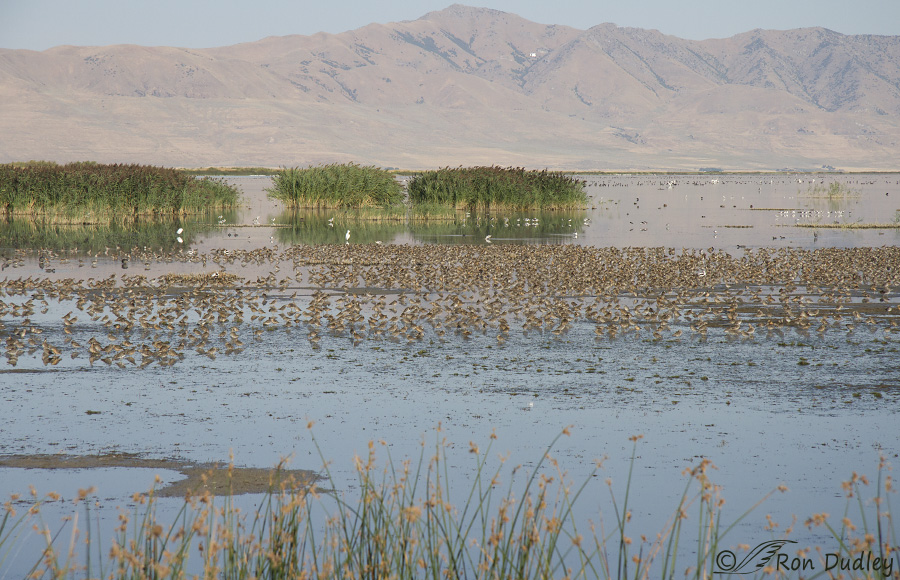
It started out peaceful and delightful. This was the scene as I was watching and enjoying incredible numbers of birds including egrets, herons, avocets, pelicans, ibis, terns, ducks, coots and geese at Bear River Migratory Bird Refuge. But the majority of the birds in front of me were Long-billed Dowitchers – there were countless numbers of them. The dowitchers you see here in the middle distance only represent a very small percentage of those that were close to me. I hesitate to guess at the numbers but the dowitchers alone were a very impressive sight.
The Great Salt Lake and its environs is one of the major rest stops for dowitchers as they migrate south from their tundra breeding grounds in extreme northern Alaska and Canada to their wintering grounds, mostly in Mexico.
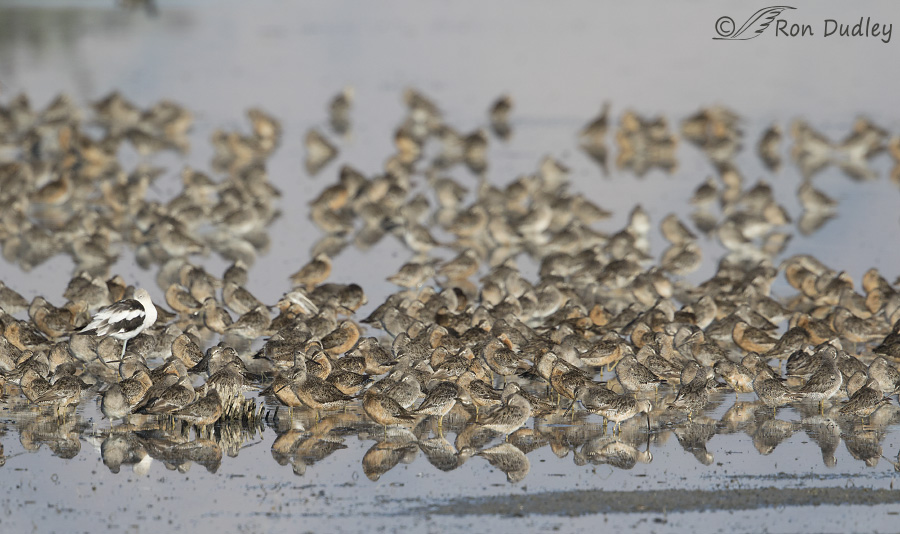 1/3200, f/6.3, ISO 500, Canon 7D Mark II, Canon EF 500mm f/4L IS II USM + 1.4 tc, not baited, set up or called in
1/3200, f/6.3, ISO 500, Canon 7D Mark II, Canon EF 500mm f/4L IS II USM + 1.4 tc, not baited, set up or called in
And resting they were. In fact most were sleeping with their long bulls tucked under their wings. To be perfectly honest I wasn’t particularly enthusiastic about photographing large clusters of birds like this but I popped off a couple of shots of them without changing my settings meant for other purposes. To me this photo almost looks like its been processed with some kind of weird “artistic” filter but all I did was crop and sharpen the image. Upon closer inspection I actually kind of like it for its depth of field gradient and the lone, contrasting avocet at left.
But this peaceful scene changed dramatically at 8:24 am when…
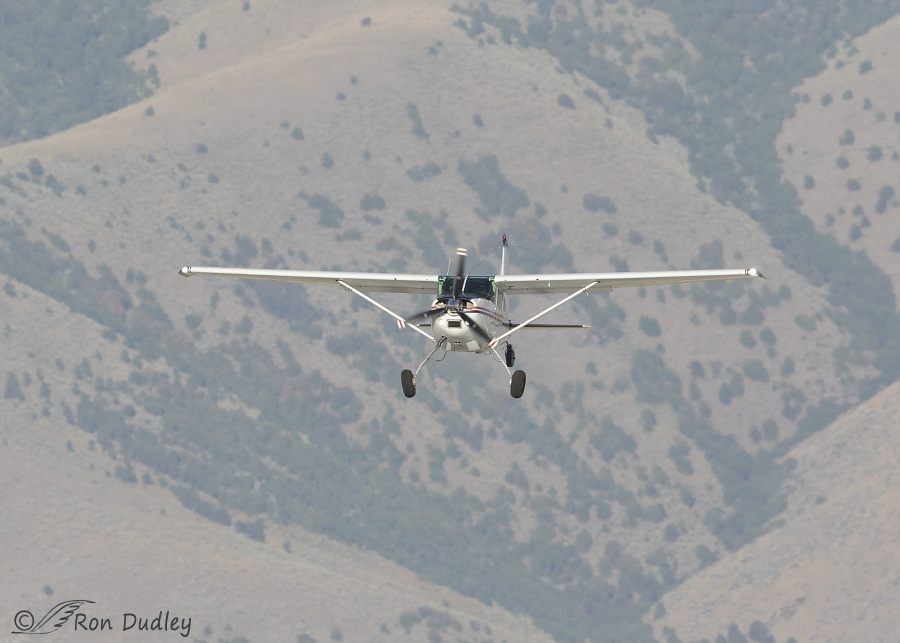
1/2500, f/8, ISO 500, Canon 7D Mark II, Canon EF 500mm f/4L IS II USM + 1.4 tc
this Cessna aircraft approached from the northwest. It was coming in almost directly at me at a very low altitude – as you can see from the image its flight path and angle as it approached were almost level with me, indicating that it was very low.
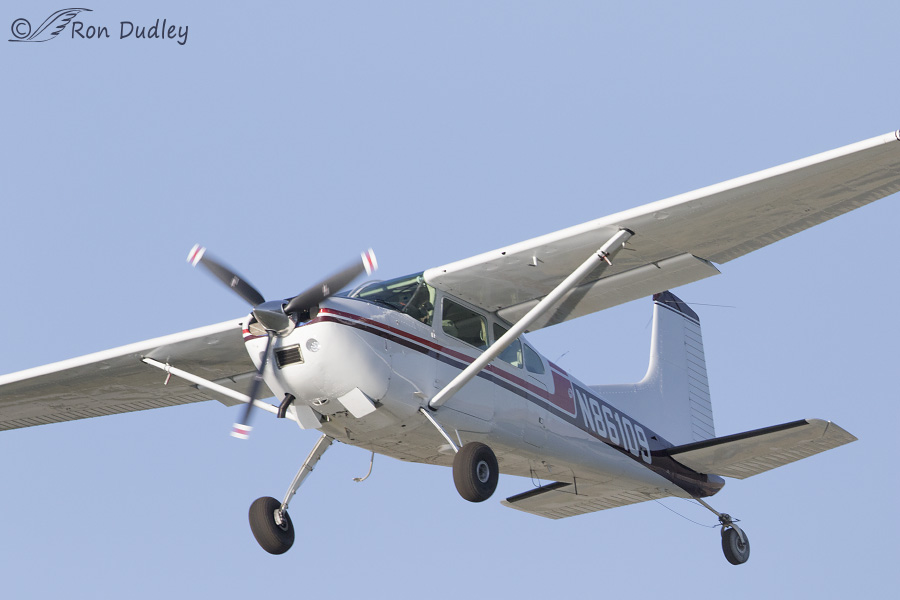
1/2500, f/8, ISO 500, Canon 7D Mark II, Canon EF 500mm f/4L IS II USM + 1.4 tc
As it passed overhead I estimated it was only about 100′ off the deck (maybe it was slightly more. I can’t be sure but it was very low). This image is full frame (uncropped) and was taken just before it passed slightly to my left.
You can imagine its effect on the serene and peaceful scene below – it was…
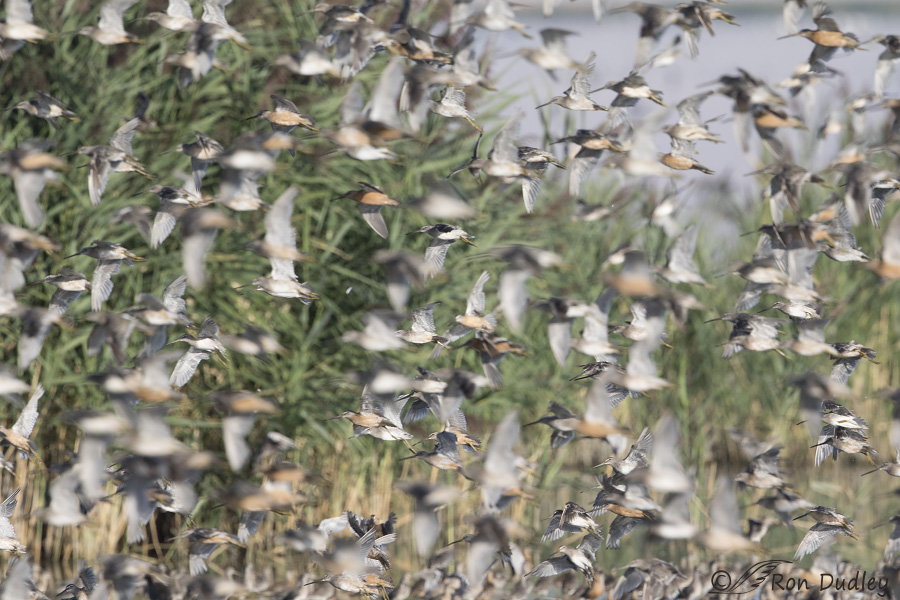
1/1600, f/8, ISO 500, Canon 7D Mark II, Canon EF 500mm f/4L IS II USM + 1.4 tc, not baited, set up or called in
pure pandemonium – you can only imagine the sound!
Many thousands of birds, including these dowitchers, lifted off in a panic with nowhere safe to go. After the plane passed the dowitchers soon landed in the water where they were before but it took several minutes before they settled down again. Many other birds left the area entirely and for some minutes afterward waves of birds passed overhead from behind me – birds that had obviously been scared up by the plane after it passed me.
These dowitchers (other migratory species too) are here to rest and recuperate during their strenuous migration of many thousands of miles and the last thing they need is added stress and wasted energy while they’re here.
My initial assumption had been that the pilot was just some joy-riding jerk getting his kicks out of harassing birds (and bird lovers, there were two other vehicles behind me whose occupants were enjoying these birds). But when I got home I looked up the tail numbers of the plane on the FAA Registry and discovered that it’s owned by the State of Utah. So perhaps these were state employees on some kind of official mission but if that’s the case I simply don’t understand why they had to fly so low and stress the birds as much as they did. Migrating birds are often counted from aircraft but even if that’s what they were doing it seems counterproductive (in more ways than one) to be flying anywhere near this low directly over so many birds.
If anyone can think of a good reason why state employees would be flying this low over so many birds on a Federal Wildlife Refuge I’d love to hear it.
I’m at a loss…
Ron
Notes:
- I won’t be reporting this incident to the FAA. I’ve done that twice before and nothing ever came of it, either time. FAA claims that in order to act there must be proof in the photographic evidence that the aircraft was flying below legal limits.
- After I posted this I noticed that on the FAA registry of the plane the Utah Division of Wildlife Resources is listed under “Other Owner Names”.
Addendum: At the urging of my good friend Jay Banta, retired manager of Fish Springs National Wildlife Refuge, I’ve contacted a specific LEO (law enforcement officer) at Bear River MBR. I had a long phone conversation with him and provided him a link to this blog post. He appreciated being notified of the incident and he most certainly will investigate.
One more late addition. Several readers have asked to see a close-up of one of the dowitchers because they’ve never seen them before.
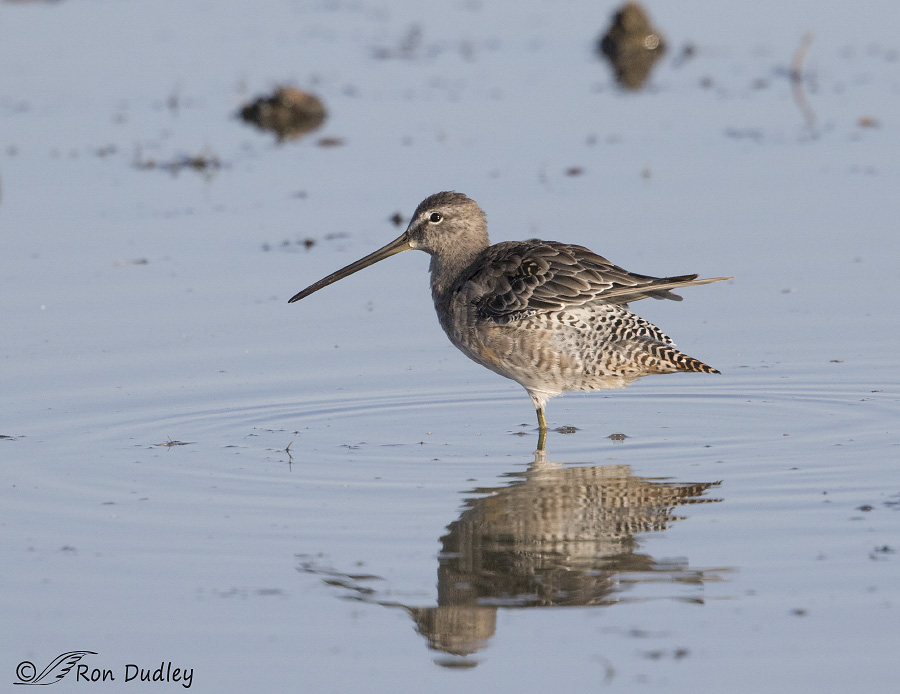
This is the best I can do. I wasn’t very close to the bird so this is a substantial crop but I think it gives an acceptable look at one of them.


This plane is on an official mission for the UDWR’s GSL program to estimate how many birds use GSL over time. GSL is so vast, has so many different microenvironments and many of the areas are so inaccessible it is imperative for biologists to take a birds eye view to estimate bird populations and what areas of the lake they are using. These plane surveys have been going on for a couple of decades and have vastly improved our understanding of the bird use at Great Salt Lake both in terms of bird numbers and what part of the lake they use at different water levels and other environmental conditions. Because they have been going on for such a long time in a systematic manner (plane height, area, time of year etc) it has helped make informed decisions about land development and other proposed impacts to GSL and it’s birds. This survey is done 5 times per year in conjunction with surveys done from airboats, boats, and on the ground. These small birds are nearly impossible to ID even flying at that low elevation. Hope that helps! These really are the good guys and gals out there working for the birds and the lake.
Hi Jaimi,
You know that I’ve always supported the Great Salt Lake Institute and its projects and in general I also support any program, including the GSL program, that endeavors to learn more about the Great Salt Lake ecosystem and its environs. We all love that lake! And I agree that plane surveys of bird populations are often an essential part of that research.
But unless I can be convinced otherwise (I’m always willing to learn based on reliable evidence and facts) I’d argue that flying this incredibly low over huge numbers of migrating birds runs the very real risk of causing significantly more harm than good. There are many documented instances of scientific researchers (all with good intentions) eventually being forced to abandon certain field techniques because of the harm they cause – just one example would be placing radio transmitters and antennae on Greater and Lesser Scaups to follow their movements. It turned out that the hardware on the birds significantly reduced their reproductive success. That method has recently been abandoned at Red Rock Lakes National Wildlife Refuge for that very reason.
Just because the DWR plane has been flying this low over birds for “a couple of decades” doesn’t necessarily mean it’s the best way to accomplish the goal. In fact it might even suggest that it’s time to reevaluate the method.
Maybe you had to be there to understand my concern – directly under the loud plane flying at about 150′ elevation (twice the width of my home) and causing pure panic and pandemonium in countless thousands of migrating birds. I’ll never forget it.
I wonder if any of the presumed biologists in that plane have ever been in the situation I was and witnessed what I did in such close proximity to so many affected birds. I really have no doubt that they’re the “good guys and gals” and that their intentions are admirable but perhaps it’s high time to question at least one of their methods – flying so very low over large numbers of birds.
If anyone else did the same thing it would be called wildlife harassment and they would be prosecuted.
Maybe they (UDWR’s GSL) should consider photographs as is done in some other areas to determine bird numbers and species. I personally feel that the comment is an excuse to continue on. There has to be a better and more sustainable way to monitor populations without flying at 150 feet during migration! Just the way I feel.
They do photo surveys from high elevations for some species at Great Salt Lake! These particular species they survey for are too small to ID from photos. The logistics of counting photos are very immense and it is very difficult to not double count or reference the photos in relation to each other.
I hate it that humans routinely do things the way we’ve always done it just because that’s the way we’ve always done it. And because that’s the way we’ve always done it, we simply accept that way of doing things without expending the energy and thought processes to find a better way. That’s because we rarely, if ever, think about things from the perspective of the birds (or any other critter outside of what’s good/easy for humans). Why not just walk in there, quietly, without the need to create panic, chaos and mayhem? What’s wrong with doing it THAT way beyond that it’s not the way we’ve always done it? Humans seem to HATE change and resist it mightily, despite that there are better ways of doing things.
These areas are large and inaccessible to walking. Where surveys can be done other ways they are: walking, cars and photos. This is one tool used to monitor increases and decreases in bird populations each year. The birds move and change habitat in response to environmental changes such as water levels, salinity etc. If biologists only counted walking accessible areas they would miss out on a large part of Great Salt Lake.
How should DWR continue this monitoring and be able to compare previously collected data across these years while still capturing what is going on in bird populations across the changing lake over time? Changing a protocol would mean a reset of the invaluable years they have collected the data. The longevity and systematic collection is the power of their data. Without data collected by these surveys evaporation ponds would have been built over important bird areas, much of the knowledge of pelicans would not exist, we would not know how many overwintering waterfowl come to the lake each year…. Is it worth abandoning that protocol to not disturb the birds and their photographers (and hunters) for a few minutes 5 days per year? I agree we should ask questions and have discussions. That is why I joined in this thread :). I challenge the assertion that these surveys do more harm than good when done 5 days per year and used as a tool in a larger tool chest. I also think comparing plane surveys to an invasive capture and radio collar is unfair (scaup example). I think the benefits far outweigh the costs especially given the power of statistics in a changing landscape.
Has anyone suggested Drones flying over these areas and photographing the populations? They wouldn’t make the same noise, nor be as big as a plane and probably wouldn’t significantly impact the data protocols.
Hi Jaimi,
My response will assume that your comment was directed at me and what I’ve said in this post since you did refer to several of my statements.
A. I didn’t “assert” that the surveys do more harm than good. I said they run the real risk of doing so. I didn’t make the claim (assertion), I only suggested that it’s possible. There’s a big difference.
B. I don’t give a hoot about photographers or hunters or anyone else who may be disturbed by periodic and legitimate aerial biological surveys and I never intimated that I did.
C. I’m not suggesting that aerial bird surveys be “abandoned”. In fact I support them wholeheartedly. What I am suggesting is that those planes don’t need to fly this incredibly low over huge numbers of migrating birds. Sampling/counting methods could surely be revised so they could be as accurate or nearly so at a more reasonable and less invasive altitude. Besides, how can you “count” 50,000 + birds that have just been scared witless and are flying in tight, panicked flocks? I’ve seen planes doing bird surveys at several other National Wildlife Refuges over the years and never once was one of those planes flying anywhere near this low.
D. I mentioned the scaup situation only as an example of research methods that have been abandoned because of their negative effects on birds. Why you would think that to be unfair I just don’t understand. If these aerial surveys at that altitude aren’t “invasive” I don’t know what is and they’re invasive on an infinitely larger scale.
E. Have the real effects on birds of research aircraft flying THIS LOW over huge numbers of migrating birds ever been studied? Do you know? Radio monitors on scaups at RRLNWR were abandoned because their affects on the birds were studied and they turned out to be negative..
Is there a limit as to how low these planes can fly above the surface of the water during the surveys? Is their elevation above the water specified minimally? Or are they allowed to go as low as they please over birds? I suspect this aircraft may have been lower than it should have been, even for a survey plane.
And possibly lower than you realize.
I’d also like to see a closeup of the dowitcher which i’ve never seen before…
thanks
liza
Done, Elizabeth (and Susan Stone). I’ve added a “close-up”.
Sigh.
And hiss and spit.
I hope there was a half-way reasonable excuse for terrorising the birds. But somehow doubt it.
I doubt it too, EC, but you never know for sure…
I am late replying to this post, and once I got past the XX!!@@^^,,<>XX, and read all the replies, I agree that you did well!! I am glad you had someone in law enforcement you could talk to. However, I also agree with exposing them.
It is similar to taking pictures of individuals or groups that show inappropriate behavior toward Owls. It is amazing once people realize there is evidence of inappropriate behavior, how well behaved others become. Yes, it does take time, but the end result is what counts, especially as more and more people become aware of the correct way to act around wildlife.
Dick, I was once chastised by a reader for photographing a woman breaking the law on Antelope Island and posting those photos. He basically thought I was invading her privacy. My response was essentially that I’d continue to do the same thing in similar circumstances for the reason you mention. Thankfully all my other readers who commented supported me…
I support you 1001%….and then some!!! That woman forfeited her “right to privacy” by her dumb choice of action….choices have consequences. The mature accept the consequences of their actions–.the others don’t matter…..they are just a waste of oxygen, water, other resources and space on Earth…
I remember that you supported me back then too, Patty. Thanks for that.
I’m with you Patty! And I’m sure we’re not alone in this feeling! Certainly not in this group…LOL!
That aircraft is owned by the state of Utah, according to the restoration number. Nice,huh?
Yup, I had mentioned that fact in my blog and provided a link to the FAA site that included info on the ownership of this aircraft, Jim. In fact it’s operated by Utah Division of Wildlife Resources.
Ron, here is a suggestion…my opinion is that to get any change from these types of agencies, the best thing is to expose them in the public media. I bet an article or two in the local SLC news media showing this story would be all it takes… expose them. If they were counting birds (doubtful) they would do it differently… perhaps it was some state employees misbehaving. Either way, it does not matter, it is negatively impacting the wildlife and it looks to be intentionally done — using state government dollars and resources. Expose them…
Ed, I’ve notified law enforcement at the refuge and I’d like to see how that plays out first. I don’t want to go off half-cocked – after all there may be mitigating or extenuating circumstances that I’m unaware of.
That makes sense Ron, find out if there low flight(s) are actually planned and approved, etc.
YEAH!!! That a boy RON!!!!
I figured you’d appreciate that I contacted them, Marina. This enforcement officer has an excellent reputation and I’m confident he’ll do right by the situation, whatever that may be.
YAY Ron! I KNOW how frustrating it can be to hold peoples’ feet to the fire when they’re behaving badly, but we’ve still got to TRY to make it happen. Generally, it’s a matter of sheer ignorance, and with a little education, you CAN change the behavior. It’s just tough to get folks in charge to LISTEN and then ACT. While I don’t know the game wardens here in NY (MY bad), in other states I’ve lived (Texas, Colorado and Wyoming) I knew them well and they were responsible and fair.
That kind of behavior leaves me speechless. I would love it if you got some good close-ups of the Dowitchers, a bird I’ve never seen.
Susan, In a few minutes I’ll email you an image taken from as close as I got.
I tried sending the image to the email address your comments come in on but it was returned as undeliverable. It said that the “email account doesn’t exist”. Don’t know why…
Sometime even people who you think would know better don’t. My experience has shown some biologist have little regard for the effects on the animals of their research. Perhaps if you let the staff at the refuge visitor center know about your experience they can pass on better behavior advice to the pilot of the plane
I have been fascinated watching all the dowitchers at the refuge this year. I had a noisy Harley on the loop Sunday that flushed all the birds too. The sound of all those wings was incredible. I scowled my evil look at the bikers as they passed.
April, Noisy Harley’s (and other loud motorcycles) on refuges are an anathema to me. If it were up to me I’d outlaw them on refuges.
Ron please report it again!!!!! Please!!! Go to headquarters with your pictures. Do you realize here in grand junction 2 division of wildlife employees were arrested for poaching. Got to keep after them. Terrible!!!!Some care about the birds. I know a DOW employee here. He has a spotting scope and he checkes on eagles and such regularily. But to some its just a job. No love!
Been there, done that, Marina. Twice. I’m no fan of beating my head against a wall.
That’s a disgusting story about the wildlife officers being arrested for poaching. I hope they’re still trying to swallow the book that was thrown at them…
Unfortunately the book was not thrown merely tapped!
Even worse than bad light!
Charlotte
It sure was, Charlotte.
BAH I hope they have a freakin’ good reason but what the heck. What the actual heck? 🙁
I can’t imagine what it would be, Arwen. The only thing I could come up with is that they were preparing to land so they had to be low. But there’s no place they could land nearby.
Sigh……… Guess they are no different that private citizens. You’d think they’d be concerned about a bird strike at that low altitude, but, if they are that brainless………….. It surely is an impressive number of birds in a small area and I do like the depth of field effect! 🙂 We get that type of thing from Air Force helicopters when it’s getting close to big game season here. 🙁
I wondered the same thing about bird strikes, Judy. If a pelican or goose had lifted off in front of them it sure would have got their attention!
Several times a day I’m forced into shaking my head and asking, “What’s WRONG with humans?” This was one of those times. Sigh…
I don’t see any logical, good reason for this either, Laura. Because I don’t see it doesn’t necessarily mean it doesn’t exist I guess but as I said I’m at a loss…